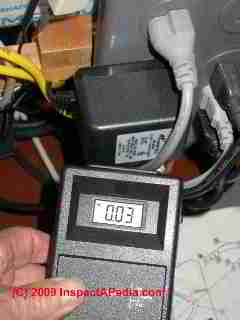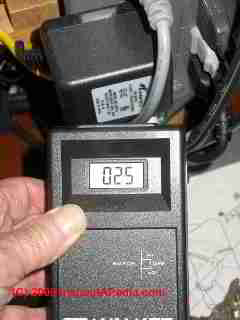Guide to Using Electromagnetic EMF Measurement Instruments
InspectAPedia tolerates no conflicts of interest. We have no relationship with advertisers, products, or services discussed at this website.
This article explains how to use EMF or ELF measuring instruments when performing electromagnetic field (EMF) or electromagnetic radiation EMR measurements either by engaging a professional or by consumers using low-cost instruments which measure EMF exposure levels in gauss or milligauss.
We discusses sources of error and variation in EMF measurements and we review and make suggestions for using several low-cost EMF measurement devices to determine the instantaneous electromagnetic field exposure..
EMF Measurement Instrument Use
For position-insensitive equipment, a single reading is usually provided, directly in mG.
For position sensitive equipment you'll find an enormous range of response depending on the angle and direction in which you hold the measurement device.
While this type of instrument is more work to use (see calculations below and in spread sheet) it provides more clear indication of when you're approaching a field. Some instruments do not provide a reading directly in mG and you'll have to simply record the "raw" measurements and to convert them later.
Definition of Gauss versus Milligauss Field Strength Measurements
Some readers may be confused between two common terms used to describe the strength of an electromagnetic field: Gauss and Milligauss. Both of these terms measure the same effect, but at different ranges of strength level. It's simply a matter of moving the decimal point, as we demonstrate in our photographs above.
In our first photo the ELF EMF meter has been set to the Gauss range and we are measuring a field strength of 0.03 Gauss with our meter touching a small power transformer.
In our second photo the same ELF EMF meter has been set to its more-sensitive Milligauss range and we are measuring 25 milligauss.
Because usually the electromagnetic field strength around residential properties is very weak, most measurements will probably be made in the milligauss range. 0.03 Gauss is the same as 30 Milligauss.
Our instrument, more accurate in the lower milligauss range, shows that we are actually measuring 25 milligauss, a number which was rounded up to 0.03 Gauss when the scale was shifted.
Definitions of Gauss and Milligauss for Measuring Electromagnetic Fields - EMF
Gauss is a measurement scale used to measure the strength of an electromagnetic field (EMF). The gauss level measured in a given location depends on the strength of the source of the EMF and the distance from the source. The measured field strength of an EMF falls off quite rapidly with distance (field strength declines as the square of the distance from the source).
When electrical current flows through a wire (such as in an electrical distribution wire or inside of an electric motor) an electromagnetic field is produced.
Power lines, local electrical wires, air conditioning motors, computers, TVs, hair dryers, toasters, all devices that use or transport electricity will produce an electromagnetic field.
Usually the strength of these fields is low (Electric fan 1 mG, TV 1mG, chain saw 2.5 mg(?) at chest height, electric stove 6 mG, older electric blankets before circuit redesign 20 mG, and under a distribution line for electrical power transmission, 2-20 mg depending on the line height, KVA rating, and actual level of usage at the time of measurement.
If there is a concern for measuring exposure or possible exposure to electromagnetic fields, it's critical that we have a correct understanding of the levels of exposure that are being examined.
For example, one of our readers informs us that that manufacturer of his pacemaker recommends avoiding exposure to electromagnetic fields stronger than 5 gauss. (EMF generated from small electric motors (such as a chain saw) measured with the saw held in normal operating position may be as much as 2.6 Gauss at the user's chest.)
When recording EMF measurements be certain that you've got the right order of magnitude.
1 Milligauss (mG) = 10-3 Gauss, or 0.001 Gauss
Published sources provide lots of examples of producing and measuring electromagnetic fields at a known gauss level. For example, using a 1.5V battery and a 150 Ohm resistor to make a long straight wire circuit, the EMF field strength when measured at 0.1m (about 4") from the wire will be about 0.2 milligauss (mG).
NIST, focused on SI units, measures electromagnetic fields in Tesla units of magnetic flux density: magnetic flux density Tesla, Symbol: T
SI Derived unit: Wb/m2
SI Base: kg·s-2·A-1
and
Magnetic Fluxe is measured in Weber, Symbol: Wb
SI Derived Unit: V·s
SI Base Units: m2·kg·s-2·A-1




